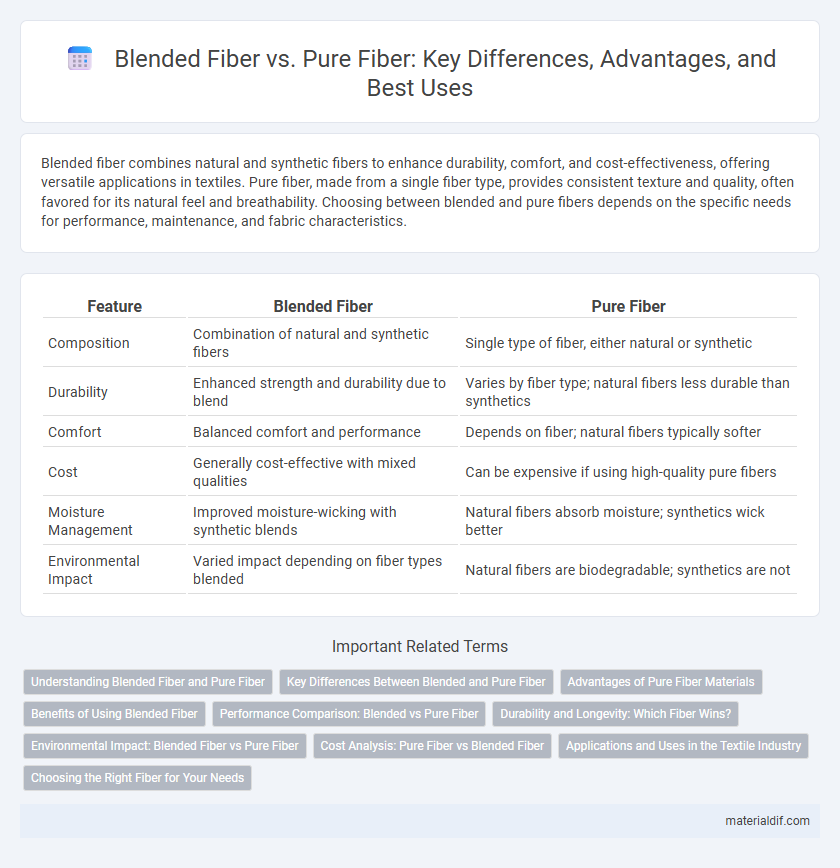Blended fiber combines natural and synthetic fibers to enhance durability, comfort, and cost-effectiveness, offering versatile applications in textiles. Pure fiber, made from a single fiber type, provides consistent texture and quality, often favored for its natural feel and breathability. Choosing between blended and pure fibers depends on the specific needs for performance, maintenance, and fabric characteristics.
Table of Comparison
| Feature | Blended Fiber | Pure Fiber |
|---|---|---|
| Composition | Combination of natural and synthetic fibers | Single type of fiber, either natural or synthetic |
| Durability | Enhanced strength and durability due to blend | Varies by fiber type; natural fibers less durable than synthetics |
| Comfort | Balanced comfort and performance | Depends on fiber; natural fibers typically softer |
| Cost | Generally cost-effective with mixed qualities | Can be expensive if using high-quality pure fibers |
| Moisture Management | Improved moisture-wicking with synthetic blends | Natural fibers absorb moisture; synthetics wick better |
| Environmental Impact | Varied impact depending on fiber types blended | Natural fibers are biodegradable; synthetics are not |
Understanding Blended Fiber and Pure Fiber
Blended fiber combines two or more different fibers, such as cotton and polyester, to enhance fabric properties like durability, texture, and cost-effectiveness compared to pure fiber. Pure fiber refers to fabric made entirely from a single fiber type, like 100% cotton or 100% wool, offering uniform characteristics such as breathability or natural softness. Understanding these distinctions helps in selecting materials based on performance needs, comfort, and maintenance requirements.
Key Differences Between Blended and Pure Fiber
Blended fiber combines natural and synthetic materials to enhance durability, flexibility, and cost-effectiveness, while pure fiber consists solely of one material type, offering uniform texture and consistent performance. Pure fibers such as cotton or wool provide superior breathability and comfort, whereas blended fibers improve wrinkle resistance and stretchability, suitable for activewear and durable garments. The choice between blended and pure fibers impacts fabric characteristics like moisture-wicking, strength, and maintenance requirements, influencing the end-use suitability.
Advantages of Pure Fiber Materials
Pure fiber materials offer superior strength and durability compared to blended fibers, making them ideal for high-performance applications. They provide enhanced consistency in texture and appearance, resulting in a more luxurious and uniform fabric. Additionally, pure fibers generally offer better breathability and moisture-wicking properties, which improve comfort and functionality in textile products.
Benefits of Using Blended Fiber
Blended fiber combines natural and synthetic materials to enhance durability, comfort, and moisture-wicking properties, outperforming pure fiber in versatility. This fusion offers improved elasticity and resistance to wear and tear, making clothing and textiles more long-lasting and easier to care for. Blended fibers also enable cost-effectiveness by reducing production expenses while maintaining high-quality performance standards.
Performance Comparison: Blended vs Pure Fiber
Blended fiber incorporates a mix of natural and synthetic materials, enhancing durability and flexibility compared to pure fiber, which consists entirely of one type of material. Pure fiber often offers superior moisture-wicking and breathability, making it ideal for specific athletic or sensitive-skin applications. Performance differences hinge on the intended use, with blended fiber excelling in strength and resilience, while pure fiber maximizes comfort and natural fiber properties.
Durability and Longevity: Which Fiber Wins?
Blended fibers combine the strengths of different materials, resulting in enhanced durability and resistance to wear compared to pure fibers, which may be more prone to specific weaknesses. Pure fibers, such as 100% cotton or wool, offer natural resilience and breathability but often lack the strength and abrasion resistance found in blends. Overall, blended fibers generally outperform pure fibers in longevity due to their optimized balance of flexibility, strength, and resistance to environmental factors.
Environmental Impact: Blended Fiber vs Pure Fiber
Blended fibers combine natural and synthetic materials, often complicating recycling processes and increasing landfill waste compared to pure fibers, which are typically easier to recycle and biodegrade more efficiently. Pure fibers, such as organic cotton or wool, generally have a lower environmental footprint due to reduced chemical treatments and better compostability. The environmental impact of fiber production heavily depends on the lifecycle, with pure fibers offering a more sustainable alternative in terms of biodegradability and recyclability.
Cost Analysis: Pure Fiber vs Blended Fiber
Pure fiber networks typically involve higher initial capital expenditures due to the need for dedicated fiber optic cables and specialized equipment, resulting in increased deployment costs. Blended fiber solutions, combining fiber with other transmission media like copper or wireless, offer reduced installation expenses and enhanced flexibility, often lowering overall operational costs. Cost analysis reveals that while pure fiber ensures superior performance and longevity, blended fiber presents a more budget-friendly alternative suitable for incremental upgrades or mixed infrastructure environments.
Applications and Uses in the Textile Industry
Blended fiber combines natural and synthetic fibers, enhancing fabric durability, flexibility, and cost-effectiveness, making it ideal for sportswear, upholstery, and casual clothing where performance and affordability are crucial. Pure fiber, such as 100% cotton or wool, offers superior comfort, breathability, and hypoallergenic properties favored in high-end fashion, luxury apparel, and bedding products. Textile manufacturers prioritize blended fibers for mass-market products due to their strength and ease of care, while pure fibers remain preferred for premium, sustainable, and specialized textile applications.
Choosing the Right Fiber for Your Needs
Selecting between blended fiber and pure fiber depends on your specific needs and preferences, as blended fibers combine the strengths of different materials to enhance durability, comfort, and cost-effectiveness, while pure fibers offer superior natural qualities such as breathability and softness. Blended fibers like cotton-polyester blends provide wrinkle resistance and increased fabric strength, making them suitable for activewear and everyday use. Pure fibers such as 100% wool or silk deliver exceptional warmth and luxury, ideal for sensitive skin and high-end fashion applications.
Blended Fiber vs Pure Fiber Infographic

 materialdif.com
materialdif.com